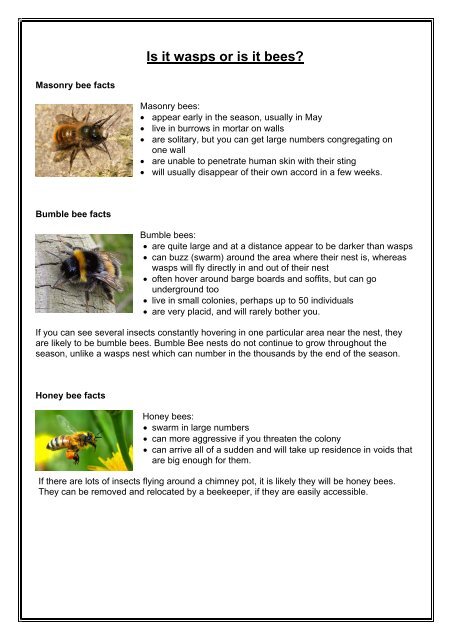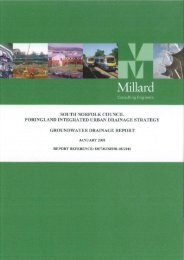have a look at this bee factsheet and see what best describes your ...
have a look at this bee factsheet and see what best describes your ...
have a look at this bee factsheet and see what best describes your ...
- No tags were found...
Create successful ePaper yourself
Turn your PDF publications into a flip-book with our unique Google optimized e-Paper software.
Is it wasps or is it <strong>bee</strong>s?Masonry <strong>bee</strong> factsMasonry <strong>bee</strong>s: appear early in the season, usually in May live in burrows in mortar on walls are solitary, but you can get large numbers congreg<strong>at</strong>ing onone wall are unable to penetr<strong>at</strong>e human skin with their sting will usually disappear of their own accord in a few weeks.Bumble <strong>bee</strong> factsBumble <strong>bee</strong>s: are quite large <strong>and</strong> <strong>at</strong> a distance appear to be darker than wasps can buzz (swarm) around the area where their nest is, whereaswasps will fly directly in <strong>and</strong> out of their nest often hover around barge boards <strong>and</strong> soffits, but can gounderground too live in small colonies, perhaps up to 50 individuals are very placid, <strong>and</strong> will rarely bother you.If you can <strong>see</strong> several insects constantly hovering in one particular area near the nest, theyare likely to be bumble <strong>bee</strong>s. Bumble Bee nests do not continue to grow throughout theseason, unlike a wasps nest which can number in the thous<strong>and</strong>s by the end of the season.Honey <strong>bee</strong> factsHoney <strong>bee</strong>s: swarm in large numbers can more aggressive if you thre<strong>at</strong>en the colony can arrive all of a sudden <strong>and</strong> will take up residence in voids th<strong>at</strong>are big enough for them.If there are lots of insects flying around a chimney pot, it is likely they will be honey <strong>bee</strong>s.They can be removed <strong>and</strong> reloc<strong>at</strong>ed by a <strong>bee</strong>keeper, if they are easily accessible.
Bee inform<strong>at</strong>ion provided by the Norfolk Bee Keeping Associ<strong>at</strong>ionResponsibility for <strong>bee</strong> swarmsThe swarm is not the responsibility of the <strong>bee</strong>keeper. The swarm isthe responsibility of the person on whose property it has settled <strong>and</strong>remains so until it has <strong>bee</strong>n removed. In the event th<strong>at</strong> it cannotsafely be removed then the owner of the property must decide onwh<strong>at</strong> action he or she will take.Solitary BeesThese are sometimes referred to as mining <strong>bee</strong>s as they make small holes in the soft mortarjoints in brickwork. Holes in airbrick's, <strong>and</strong> the ends of garden canes, are also used by the<strong>bee</strong>s for egg laying.They <strong>look</strong> like honey <strong>bee</strong>s but are sometimes slightly larger <strong>and</strong> slower in their movements.They can appear in April when the we<strong>at</strong>her warms up <strong>and</strong> the eggs, which are laid theprevious spring, h<strong>at</strong>ch <strong>and</strong> adult <strong>bee</strong>s appear. The adults usually survive about 6-8 weeks<strong>and</strong> during <strong>this</strong> time they m<strong>at</strong>e <strong>and</strong>, in the holes from which they <strong>have</strong> emerged, lay the eggsfor next years <strong>bee</strong>s.Most do not sting <strong>and</strong> any th<strong>at</strong> could do not because the sting is normally too weak topenetr<strong>at</strong>e the human skin. Left alone they will not usually cause any harm. The numbersappearing <strong>at</strong> any one time is about 20/50 <strong>and</strong> unlike the honey <strong>bee</strong> they do not swarm.It is almost impossible to remove them <strong>and</strong> it is illegal to poison them. To try <strong>and</strong> stop themreappearing next year, the holes could be blocked with new mortar or some type of builder'ssealant. It is unwise to block airbricks as they are there for a purpose <strong>and</strong> should be left open.They are useful as pollin<strong>at</strong>ors, so will be <strong>see</strong>n working on flowers along with the honey <strong>bee</strong>.Bumble <strong>bee</strong>sThese are easy to identify with their round black furry bodies <strong>and</strong>football jersey liked stripes of either: yellow, orange or rustycoloured.The "Queen" emerges from hibern<strong>at</strong>ion in the spring <strong>and</strong> feeds onnectar <strong>and</strong> pollen. When the time is right she then searches out asite for the nest, <strong>this</strong> could be:disused mouse nests undergroundcompost heaps or bins (these are favourite places)unused bird nesting boxesunder garden sheds <strong>and</strong> other buildings (another favourite place)in wood pilesin thick tufts of grass.Once the site has <strong>bee</strong>n selected the queen then starts to lay eggs <strong>and</strong> from these come theyoung <strong>bee</strong>s, which are small to start with but grow quite quickly if sufficient food is available.A bumble <strong>bee</strong> nest usually never totals more than a few hundred <strong>bee</strong>s, often quite a lot less.
The nest dies out during l<strong>at</strong>e summer/early autumn, only the queen surviving until thefollowing spring.Bumble <strong>bee</strong>s are harmless <strong>and</strong> will only get agit<strong>at</strong>ed if the nest or its entrance is disturbed.Unlike honey <strong>bee</strong>s they do not swarm.Honey <strong>bee</strong>sThe honey <strong>bee</strong> is the only <strong>bee</strong> in <strong>this</strong> country which swarms <strong>and</strong> theswarming season is usually from mid-April until early August, with May<strong>and</strong> June being the months when swarming is <strong>at</strong> its gre<strong>at</strong>est.Several days before a swarm emerges from the hive "scout <strong>bee</strong>s" willfly <strong>and</strong> find various new sites for the swarm to go to <strong>and</strong> it will be oneof these sites th<strong>at</strong> the swarm will establish a new colony. It is notuncommon for people to mistake <strong>this</strong> "scouting" especially aroundchimneys, for actual swarms.A swarm will only leave the hive if the we<strong>at</strong>her is right <strong>and</strong> <strong>this</strong> is usually on a bright sunny<strong>and</strong> warm day with little or no wind, normally mid to l<strong>at</strong>e morning is a favourite time.Swarms are easy to spot as there are several thous<strong>and</strong> <strong>bee</strong>s <strong>and</strong> it will usually be as large asa football, sometimes larger <strong>and</strong> they all hang as one mass when they <strong>have</strong> settled. Solitary<strong>bee</strong>s <strong>and</strong> bumble <strong>bee</strong>s never swarm <strong>and</strong> compared with honey <strong>bee</strong>s there are only a few ofthese flying <strong>at</strong> any one time.Places where swarms settle are:branches of trees <strong>and</strong> shrubsin or on the outside of hedgesinside garden compost bins assuming there is spaceinside chimneys/central he<strong>at</strong>ing fluesin the cavity wall of a buildingon the outside wall of a high building.If the trees/hedges/compost bins are reasonably accessible the <strong>bee</strong>keeper should be able toremove the swarm without too much difficulty. It is almost impossible to remove honey <strong>bee</strong>sfrom a chimney or cavity if they <strong>have</strong> <strong>bee</strong>n there more than 2/3 days, as in th<strong>at</strong> time they will<strong>have</strong> started to build comb <strong>and</strong> establish themselves. They will probably survive until thewinter but because of lack of food or disease will die before spring. If it is necessary to destroythe <strong>bee</strong>s then <strong>this</strong> has to be done by a pest control company, <strong>bee</strong>keepers are not killers ofhoney <strong>bee</strong>s.



![List of outstanding appeals against planning decisions [PDF, 30 Kb]](https://img.yumpu.com/51294693/1/190x135/list-of-outstanding-appeals-against-planning-decisions-pdf-30-kb.jpg?quality=85)



![Brown bin calendar - week 2 [PDF] - South Norfolk Council](https://img.yumpu.com/49352110/1/184x260/brown-bin-calendar-week-2-pdf-south-norfolk-council.jpg?quality=85)



![Link magazine, Spring 2008 [PDF, 4,450k] - South Norfolk Council](https://img.yumpu.com/43994858/1/184x260/link-magazine-spring-2008-pdf-4450k-south-norfolk-council.jpg?quality=85)

![South Norfolk Council Volunteering Opportunities [PDF]](https://img.yumpu.com/42079564/1/184x260/south-norfolk-council-volunteering-opportunities-pdf.jpg?quality=85)
![Tiffey Valley Guide [PDF, 1,450k] - South Norfolk Council](https://img.yumpu.com/41615145/1/124x260/tiffey-valley-guide-pdf-1450k-south-norfolk-council.jpg?quality=85)
![Queen's Diamond Jubilee Fund [PDF] - South Norfolk Council](https://img.yumpu.com/41088331/1/184x260/queens-diamond-jubilee-fund-pdf-south-norfolk-council.jpg?quality=85)
